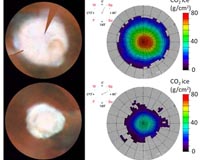 |
Paris, France (ESA) Feb 18, 2010 New measurements of ozone in the atmosphere of Mars are being obtained in a coordinated observation campaign with Mars Express and a Hawaiian-based telescope. The combined observation set covers a longer time period and broader range of regions on Mars than previous campaigns, thereby improving the ability to verify and refine detailed models of the Martian atmosphere. The Martian atmosphere has played a key role in shaping the planet's history and surface. Observations of the key atmospheric components are essential for the development of accurate models of the Martian climate. These in turn are needed to better understand if climate conditions in the past may have supported liquid water, and for optimising the design of future surface-based assets at Mars. Ozone is an important tracer of photochemical processes in the atmosphere of Mars. Its abundance, which can be derived from the molecule's characteristic absorption features in spectra of the atmosphere, is intricately linked to that of other constituents and it is an important indicator of atmospheric chemistry. To test predictions by current models of photochemical processes and general atmospheric circulation patterns, observations of spatial and temporal ozone variations are required.
Coordinated campaign - two windows on ozone These measurements can be complemented by ground-based observations taken at different times and probing different sites on Mars, thereby extending the spatial and temporal coverage of the SPICAM measurements. To quantitatively link the ground-based observations with those by Mars Express, coordinated campaigns are set up to obtain simultaneous measurements. Infrared heterodyne spectroscopy, such as that provided by the Heterodyne Instrument for Planetary Wind and Composition (HIPWAC), provides the only direct access to ozone on Mars with ground-based telescopes; the very high spectral resolving power (?/?? >106) allows Martian ozone spectral features to be resolved when they are Doppler shifted away from ozone lines of terrestrial origin. A coordinated campaign to measure ozone in the atmosphere of Mars, using SPICAM and HIPWAC, has been ongoing since 2006. The most recent element of this campaign was a series of ground-based observations using HIPWAC on the NASA Infrared Telescope Facility (IRTF) on Mauna Kea in Hawai'i. These were obtained between 8 and 11 December 2009 by a team of astronomers led by Kelly Fast from the Planetary Systems Laboratory, at NASA's Goddard Space Flight Center (GSFC), in the USA. The observations had been coordinated in advance with the Mars Express science operations team, to ensure overlap with ozone measurements made in this same period with SPICAM. The main goal of the December 2009 campaign was to confirm that observations made with SPICAM (which measures the broad ozone absorption feature centred at around 250 nm) and HIPWAC (which detects and measures ozone absorption features at 9.7 m) retrieve the same total ozone abundances, despite being performed at two different parts of the electromagnetic spectrum and having different sensitivities to the ozone profile. A similar campaign in 2008, had largely validated the consistency of the ozone measurement results obtained with SPICAM and the HIPWAC instrument (see related publication by Fast, K.E. et al. [2009]).
Results from a successful campaign Kelly and her colleagues gathered ozone measurements for a number of locations on Mars, both in the planet's northern and southern hemisphere. During this four-day campaign the SPICAM observations were limited to the northern hemisphere. Several HIPWAC measurements were simultaneous with observations by SPICAM allowing a direct comparison. Other HIPWAC measurements were made close in time to SPICAM orbital passes that occurred outside of the ground-based telescope observations and will also be used for comparison. The team also performed measurements of the ozone abundance over the Syrtis Major region, which will help to constrain photochemical models in this region.
Linking datasets for a broader perspective Putting the compatibility of the data from these two instruments on a firm base will support combining the ground-based infrared measurements with the SPICAM ultraviolet measurements in testing the photochemical models of the Martian atmosphere. The extended coverage obtained by combining these datasets helps to more accurately test predictions by atmospheric models. It will also quantitatively link the SPICAM observations to longer-term measurements made with the HIPWAC instrument and its predecessor IRHS (the Infrared Heterodyne Spectrometer) that go back to 1988. This will support the study of the long-term behaviour of ozone and associated chemistry in the atmosphere of Mars on a timescale longer than the current missions to Mars.
Share This Article With Planet Earth
Related Links Mars Express Mars News and Information at MarsDaily.com Lunar Dreams and more
 New Maps Of Polar Caps Will Refine Martian Climate Models
New Maps Of Polar Caps Will Refine Martian Climate ModelsTucson AZ (SPX) Sep 17, 2009 Scientists from the Tucson-based Planetary Science Institute have created the first detailed maps that show the amount of dry ice (solid carbon dioxide) deposited in the polar regions of Mars. The maps reveal how the ice thickness varies with the seasons. The maps were created from measurements taken by the Mars Odyssey neutron spectrometer, said PSI Senior Scientist Thomas H. Prettyman ... read more |
|
| The content herein, unless otherwise known to be public domain, are Copyright 1995-2010 - SpaceDaily. AFP and UPI Wire Stories are copyright Agence France-Presse and United Press International. ESA Portal Reports are copyright European Space Agency. All NASA sourced material is public domain. Additional copyrights may apply in whole or part to other bona fide parties. Advertising does not imply endorsement,agreement or approval of any opinions, statements or information provided by SpaceDaily on any Web page published or hosted by SpaceDaily. Privacy Statement |